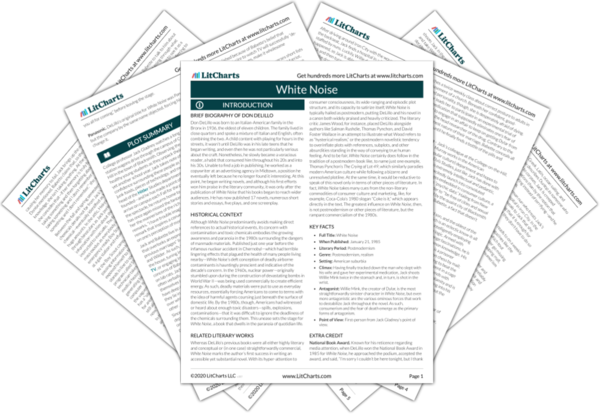TV is the most immediate means by which consumer culture is transmitted into Jack and his family’s lives. Whereas the supermarket allows the Gladneys to physically enter and interact with their culture’s psychic data, the TV passively ensnares their attention, distracting them from their own lives. When the Gladneys congregate around the TV, they hardly talk, choosing instead to fixate all their attention on the screen. At the same time, Murray makes clear that this form of entertainment shouldn’t be written off as base or destructive; instead, he argues that TV has a nuanced way of projecting messages and symbols—psychic data—and it can be productive and important if viewers know to actively search for these hidden screeds. Murray appears to value the innate hunger children harbor for the medium, believing that Wilder’s wide-eyed, unquestioning consumption denotes an understanding of the cultural underpinnings embodied by the various programs he watches. However, most of the characters seem not to treat the TV as a medium requiring inquiry and interpretation; Jack frequently hears programs and advertisements emanating from some other room, disembodied manifestations of the marketing, product placements, and perpetual entertainment making up the world around him. The TV, then, is a constant undertone of white noise in his life, rather than a stream of important messages. To Alfonse Stampanato, this explains the widespread attraction to TV footage of catastrophes. Since most viewers of TV consume it passively and uncritically, catastrophes become orienting events that cause people to snap to attention and seek meaning and emotion from an otherwise ignorable medium. Similar to how the supermarket is rife with psychic data, the omnipotent TV radiates a wide-ranging spectrum of information, leaving the viewer to sift through the various messages in search of meaning, an endeavor that is both futile and never-ending, though also—according to Murray—worthwhile.
Television Quotes in White Noise
[…] I’ve been sitting in this room for more than two months, watching TV into the early hours, listening carefully, taking notes. A great and humbling experience, let me tell you. Close to mystical. […] I’ve come to understand that the medium is a primal force in the American home. Sealed-off, timeless, self-contained, self-referring. It’s like a myth being born right there in our living room, like something we know in a dreamlike and preconscious way.
The sense of failed expectations was total. A sadness and emptiness hung over the scene. A dejection, a sorry gloom. We felt it ourselves, my son and I, quietly watching. It was in the room, seeping into the air from pulsing streams of electrons. The reporter seemed at first merely apologetic. But as he continued to discuss the absence of mass graves, he grew increasingly forlorn, gesturing at the diggers, shaking his head, almost ready to plead with us for sympathy and understanding.
I tried not to feel disappointed.












